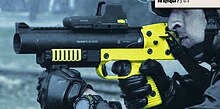Blast ball

A blast ball, also known as a tear ball or rubber ball grenade, is a ball-shaped, rubber coated, less-lethal hand grenade designed for police and corrections applications. A blast ball is similar to a traditional "flashbang" grenade in that, when detonated, it generates a loud noise and bright light. In addition, however, a blast ball will also release a chemical irritant, either OC gas or CS gas.
Application[]
Blast balls can be used against aggressive crowds during situations in which rioters significantly outnumber police or prison guards. In this application scenario, they are intended to frighten away and disperse "casual" rioters, or those who have been "sucked into" the contagion of the crowd, allowing police or prison guards to close with, and engage, the remaining "hard core" element.[1][2]
One typical deployment of blast balls occurred during the 2011 Vancouver Stanley Cup riot and was described by a Vancouver (BC) Police Department officer:[3]
We started moving forward as a line but the crowd remained still. The gap narrowed to about 5 meters and some people started to move, but many would not move until they were physically contacted. This was very risky for us as we were significantly outnumbered and stretched very thin across six lanes of a major street. Once the order was given, the first blast ball landed about 2 meters in front of the crowd and got some people moving. As more dropped, the crowd turned and ran and we drove them to the end of the block. The police line held at the intersection, which allowed negotiators to use the public address system to warn the crowd and encourage them to leave. We had pushed the crowd past all the burning cars on the block and a large number of the "lesser influenced" crowd had dispersed. What remained were the hardcore instigators and a few hundred enthusiastic participants.
Blast balls can also be used to create "negative stimulus" by detonating in areas toward which police do not want the crowd to move, allowing a "herding" effect.[1][2]
Manufacturers[]
Blast balls are marketed by AMTEC Less-Lethal Systems and by Combined Tactical Systems.[4][5]
Safety and characteristics[]
A 2015 lawsuit by a woman in Seattle, Washington alleges shrapnel from a blast ball penetrated her leg.[6] Seattle Police Department has said tests show that a blast ball detonated at contact range against ballistic gel fails to produce trauma or tearing.[1]
Blast balls manufactured by AMTEC Less-Lethal Systems weigh 212 grams and contain either 14 grams of OC gas or 12 grams of CS gas.[5][7]
References[]
- ^ a b c Myers, Chris (3 December 2010). "Crowd control with OC blast-ball grenades". PoliceOne. Retrieved 8 September 2015.
- ^ a b Carter, Mike (2 May 2013). "How Seattle police seized control of volatile May Day night". The Seattle Times. Retrieved 8 September 2015.
- ^ Burns, Thomas (2014). Risk Management of Less Lethal Options. CRC Press. p. 23. ISBN 978-1466563032.
- ^ "Tear Ball Grenades". combinedsystems.com. Combined Tactical Systems. Retrieved 8 September 2015.
- ^ a b "OC Blast Ball Grenade" (PDF). lesslethal.com. AMTEC Less Lethal Systems. Archived from the original (PDF) on 4 March 2016. Retrieved 8 September 2015.
- ^ Burton, Lynsi (21 July 2015). "Lawsuit: SPD recklessly targeted, injured volunteer medics at May Day protest". Seattle Post-Intelligencer. Retrieved 8 September 2015.
- ^ "CS Blast Ball Grenade" (PDF). lesslethal.com. AMTEC Less Lethal Systems. Retrieved 8 September 2015.[permanent dead link]
- Non-lethal weapons
- Hand grenades
- Grenades
